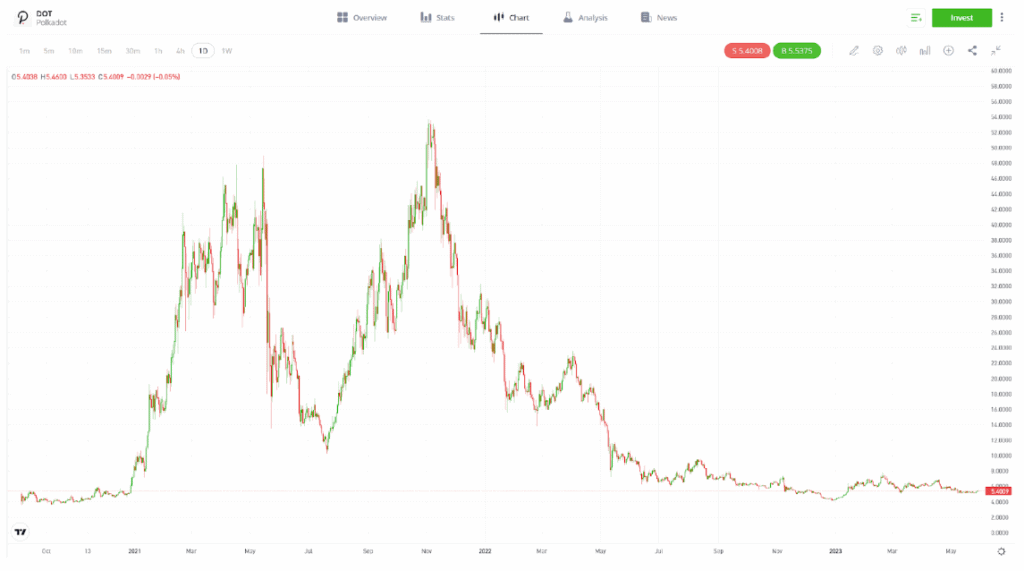Polkadot is a unique project in the Web3 space, aiming to connect a variety of crypto ecosystems to one another via a single, unified network. Learn about the history, unique characteristics and future potential of Polkadot and its native cryptocurrency, DOT.
How does Polkadot (DOT) work?
Polkadot is a blockchain platform designed to connect networks to one another in an effort to achieve interoperability between different blockchains, such as Bitcoin (BTC) and Ethereum (ETH).
Polkadot aims to improve scalability and security, while allowing different data or asset types, not just cryptocurrency coins or tokens, to be transferred between multiple blockchains.
Polkadot utilises software, known as the Substrate framework, to enable developers to quickly and easily build optimised blockchains. These blockchains can then be connected to the Polkadot network.
How is Polkadot structured?
The Polkadot network consists of a main blockchain, called the Relay Chain, and many smaller, user-created parachains and parathreads. Parachains are separate blockchains that run, and process transactions, parallel to the main Relay Chain. Parathreads are subsidiary chains tailored for specific use cases and equipped with their own crypto tokens.
Blockchains need to achieve consensus to run securely. A consensus mechanism helps blockchain networks to agree on the legitimacy of transactions and the general state of the ledger.
For Polkadot, the Relay Chain is responsible for achieving this consensus and coordinating transactions among the parachains. To do this, the parachains propose new blocks of transactions to the Relay Chain, where they are checked, validated and added to the finalised blockchain.
The Polkadot network also has bridges that connect it to other blockchains, while the Polkadot token, DOT, is used for governance and staking on the network

What makes Polkadot different?
Polkadot’s main use case involves connecting different blockchains and facilitating seamless data transfers between them. Polkadot serves as a platform on which diverse blockchain projects coexist and mutually benefit from one another in a highly scalable manner. Notably, the network’s connectivity also establishes links with prominent, preexisting networks such as Bitcoin and Ethereum.
Polkadot’s Relay Chain, the network’s main blockchain, is responsible for ensuring security and interoperability. Meanwhile, using the Substrate framework, users can create specialised blockchains with a range of use cases.
Tip: The Web3 Foundation utilises proceeds from DOT sales to support projects building on Polkadot, as well as ecosystem initiatives.

Polkadot differentiates itself from rival networks through its efficiency and scalability. It leverages the processing power of its parachains and parathreads to alleviate congestion on the Relay Chain, thus improving transaction speeds.
Using a Proof of Stake (PoS) consensus mechanism, DOT holders can stake their tokens, contributing to network security and transaction validation, while also participating in network governance.
Apps and services on Polkadot can securely communicate across chains, forming the basis for a truly interoperable decentralized web.
Polkadot
What is the DOT price and forecast for the future
Although Polkadot has a long history in terms of its development, DOT’s price history only dates back to the second half of 2020. While DOT was able to achieve a high of $55 during the 2021 crypto bull market, it ended the year with less than half that value. As is the case with many young cryptocurrency projects, the price fluctuations were relatively extreme in the early days of the token’s launch.
| Year | Start Price | Mid-Year Price | End Price | Percentage Change |
|---|---|---|---|---|
| 2020 | – | – | $9.29 | N/A |
| 2021 | $9.29 | $16.41 | $26.72 | +188% |
| 2022 | $26.72 | $7.05 | $4.31 | -84% |
Prices have been rounded to two decimal places |Past performance is not an indication of future results
Source: Yahoo! Finance
Moving forward, potential price appreciation of the DOT token will depend on Polkadot’s ability to fulfil its vision of a central blockchain network. If Polkadot achieves this and becomes the preferred method of swapping cryptoassets between chains, many investors believe that DOT will increase in value. DOT is used to make transactions, as well as in staking and governance, so if the blockchain achieves greater adoption, it stands to reason that its native cryptocurrency will too.
However, there is no way of being certain that this will happen, and even if it does, the price of DOT is not guaranteed to increase.

Past performance is not an indication of future results
Source: eToro
Who created Polkadot?
Polkadot has experienced a series of significant developments since its inception. In 2016, Dr. Gavin Wood began working on the network’s design, releasing the first draft of its whitepaper in October that same year.
The following year, the Web3 Foundation was established to support the research and development of Polkadot. A successful token sale raised $145 million for the project, before a malicious attack on the network compromised over $90 million of the raised funds.
Despite this setback, the project continued to secure additional funding through a private token sale in 2019, the same year that Kusama, a scaled-down version of Polkadot using a near-identical codebase, was launched. This served as a preliminary release of Polkadot for testing purposes.
The mainnet launch of Polkadot followed a staged rollout strategy, with various phases implemented to transition the network to its proposed Nominated Proof of Stake (NpoS) system.
In a community vote, Polkadot token holders decided to subject DOT to a redenomination process, thereby also increasing the total supply of DOT by a factor of 100, from 10 million tokens to 1 billion.
Tip: In addition to co-founding Polkadot, Dr. Gavin Wood was one of the original co-founders of Ethereum.

Final thoughts on investing in Polkadot
Polkadot is a pioneering blockchain platform that aims to connect different, distinct blockchain networks to achieve true interoperability, scalability and security. Its ability to transfer different data types or assets across multiple blockchains, coupled with the flexibility of creating custom blockchains, helps to set it apart from its competitors.
Visit the eToro Academy to learn more about Polkadot and DOT.
FAQ
- What is DOT used for?
-
DOT has two main use cases: staking and governance. Staking allows holders to earn additional DOT tokens by participating in the validation of transactions, while DOT holders involved in governance can help to shape the future of the project.
- Why is Polkadot important?
-
Polkadot’s main goal is to allow different crypto networks to easily communicate with one another, and for the users of those networks to be able to conduct activities across chains in a decentralised manner. This increased interoperability will help to create a better overall user experience in decentralised finance (DeFi), while also increasing the likelihood that blockchain technology experiences wider adoption.
- Why is Polkadot open-source?
-
Polkadot is an open-source project, which means that its code is freely available and can be reviewed by anyone. Blockchain protocols being open-source is vitally important, as it helps to remove the need for third-parties, thus increasing decentralisation. The Web3 Foundation provides a large number of resources regarding the open-source development of Polkadot.
This information is for educational purposes only and should not be taken as investment advice, personal recommendation, or an offer of, or solicitation to, buy or sell any financial instruments.
This material has been prepared without regard to any particular investment objectives or financial situation and has not been prepared in accordance with the legal and regulatory requirements to promote independent research. Not all of the financial instruments and services referred to are offered by eToro and any references to past performance of a financial instrument, index, or a packaged investment product are not, and should not be taken as, a reliable indicator of future results.
eToro makes no representation and assumes no liability as to the accuracy or completeness of the content of this guide. Make sure you understand the risks involved in trading before committing any capital. Never risk more than you are prepared to lose.


